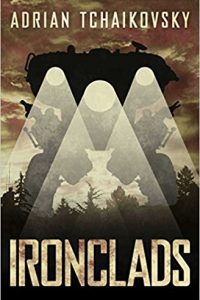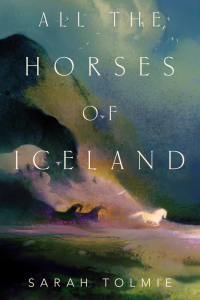Alvaro Zinos-Amaro Reviews Horror Unmasked: A History of Terror from Nosferatu to Nope by Brad Weismann
 Horror Unmasked: A History of Terror from Nosferatu to Nope, Brad Weismann (becker&mayer! 978-0760376799, $24.99, 232pp, hc) September 2023.
Horror Unmasked: A History of Terror from Nosferatu to Nope, Brad Weismann (becker&mayer! 978-0760376799, $24.99, 232pp, hc) September 2023.
Brad Weismann, author of Lost in the Dark: A World History of Horror Film, has with his latest offering accomplished something praiseworthy indeed: He has managed to compress a whole century of international genre film history into a concise but highly informative, lavishly illustrated guide that will entrance newcomers and offer plenty of neat tidbits for hardened fans. With intelligence, wit, and obvious enthusiasm, Weismann organizes his material into 24 largely chronological chapters – ‘‘different eras and cultures,’’ he notes, ‘‘produce horror cinema that is unique and appropriate to their psychic needs’’ – but he isn’t constrained by this arrangement, skipping ahead or circling back whenever it serves thematic or aesthetic cohesion.
In the introduction, where we learn that as a child Weismann watched Creature Features and read Famous Monsters of Filmland, he opines that horror possesses two key elements: ‘‘it deals with factors outside ‘normal’ experience (within us and/or outside of us), and it is threatening.’’ As he moves through the decades, he returns to test these statements, and further elaborates on the uses of horror, concluding that it ‘‘is an irreplaceable genre in world culture’’ because it allows us to safely ‘‘recreate the feeling of being reduced to predator or prey,’’ ‘‘quench suppressed impulses,’’ and ‘‘express awe and dismay in the face of the incomprehensible universe,’’ along with other factors.
Weismann’s opening chapter, a fascinating exploration of the silent era, eloquently showcases how ‘‘the seeds of feature-length horror subjects to come’’ were planted in the 1920s, including ‘‘murder, madness, curses, black magic, vampires, ghosts, mummies, werewolves, monsters, giant insects, demons, telepathy, time travel, waxworks, chambers of horrors, and even the perils of hypnosis and mind control.’’ It also sets the stage for Weismann’s approach: efficient prose, relatively light on interpretative analysis, that covers a lot of ground with historical discernment, contextualizing societal and economic pressures along the way. Insights are peppered throughout. For instance, Weismann astutely observes that The Cabinet of Dr. Caligari, in his estimation ‘‘the first great horror film,’’ ‘‘can be read as a pointed attack on the dangers of unquestioning obedience.’’ His sense of humor also shines through, as when he says, ‘‘She [The Brain That Wouldn’t Die] is not happy, and neither is anyone else by the end of the film, especially the viewer.’’ These personal touches, including a brief reminiscence about meeting Vincent Price, keep his chronicle lively and engaging.
The chapters that deal with English-language films from the ‘30s through the ‘70s, and those that generally focus on foreign-language cinema, strike me as particularly strong. Weismann often connects the historical dots in fun ways, as for example when he threads together Carnival of Sinners (1943) and It Follows (2014) via Robert Louis Stevenson, or points out that Mario Bava’s ‘‘Hatchet for the Honeymoon (1970) is a clear forerunner of Mary Harron’s American Psycho (1990).’’ Two other standout discussions: the intersection between science fiction and horror, and horror-comedies. ‘‘Comedy and horror naturally go together,’’ Weismann reflects. ‘‘Both disciplines demand timing, nuance, and surprise in order to deliver immediate, quantifiable results.’’ He credits screenwrit ers, cinematographers, production designers, composers, and actors as appropriate, which further enhances the text’s historical richness. As we near the present, Weismann surmises that ‘‘the biggest change in recent horror film is the increase in directors who neither remain specialists in ‘straight’ horror nor use horror as a stepping-stone to mainstream films.’’ This claim is bolstered by plenty of examples.
The book boasts plentiful lists, an attractive feature for casual browsers or those seeking film recommendations. There are decade-related Top Tens, and key genre figures such as Lon Chaney, Jr., Bela Lugosi, Boris Karloff, Mario Bava, and David Cronenberg, along with many others, receive their own Personal Best lists. There are also delightful asides dealing with such topics as ‘‘Best Horror Movies for Scaredy Cats,’’ ‘‘Best Horror Movies for Sleepovers,’’ ‘‘Hammer Horror’s Best,’’ and ‘‘Overlooked Gems.’’ In addition, Weismann spotlights Jamie Lee Curtis, long-running franchises, horror movie Oscar-recognition, and so on. The decade-specific lists provide an irresistible opportunity for disputation: ‘‘Brad, how could you omit Carrie, Jaws, and Dawn of the Dead from your 1970s list, while including It’s Alive and Deep Red? Outrageous! No Hellraiser, The Fly, or Poltergeist in your 1980s list? Come on!’’
As the book hits the ‘80s and beyond, the explosion of content makes the coverage feel less comprehensive. Some genre aficionados may also find Weismann biased against movies that feature heavy gore and violence, or are, as a number of modern reviewers tend to describe them, ‘‘gnarly.’’ This may explain, for example, why Terrifier and Terrifier 2 aren’t mentioned, though they have made a splash with a number of fans. Dealing with recent movies, Weismann’s counts are sometimes off, as when for example he writes that The Purge has prompted ‘‘three sequels to date’’ (it’s four, plus a two-season television series), or lists the Halloween franchise as having 12 entries (it’s 13, and elsewhere the text references the most recent one, Halloween Ends [2022]). His list of remakes and reboots misses the third The Body Snatchers treatment, Abel Ferrara’s Body Snatchers (1993), though he does credit Ferrara for other movies. South Park gets a shout-out, but The Simpsons’ well-known ‘‘Treehouse of Horror’’ episodes aren’t mentioned. In short, minor items.
Other books, such as James Marriott & Kim Newman’s Horror: The Definitive Guide to the Cinema of Fear, which in its hardcover edition in some ways resembles Horror Unmasked, have explored similar territory. But Weismann’s, which includes a solid bibliography, rises above. He strikes a commendable balance between sure-footed historicity, global sweep, effortless didacticism, and a celebration of all that is joyous in a genre that can sometimes be quite grim. Weismann has pulled off an enviable trick, producing a treat that renders the pleasures of the spooky season a perennial affair.
Alvaro Zinos-Amaro, Roundtable Editor, is co-author of a book of interviews with Robert Silverberg, Traveler of Worlds, that was a Hugo and Locus Award finalist in 2017. Alvaro’s more than 30 stories and 100 reviews, essays and interviews have appeared in magazines like Clarkesworld, Asimov’s, Apex, Analog, Lightspeed, Nature, Strange Horizons, Beneath Ceaseless Skies, Galaxy’s Edge, Lackington’s, and anthologies such as The Year’s Best Science Fiction & Fantasy 2016, Cyber World, Humanity 2.0, and This Way to the End Times.
This review and more like it in the December and January 2023 issue of Locus.
 While you are here, please take a moment to support Locus with a one-time or recurring donation. We rely on reader donations to keep the magazine and site going, and would like to keep the site paywall free, but WE NEED YOUR FINANCIAL SUPPORT to continue quality coverage of the science fiction and fantasy field.
While you are here, please take a moment to support Locus with a one-time or recurring donation. We rely on reader donations to keep the magazine and site going, and would like to keep the site paywall free, but WE NEED YOUR FINANCIAL SUPPORT to continue quality coverage of the science fiction and fantasy field.
©Locus Magazine. Copyrighted material may not be republished without permission of LSFF.








